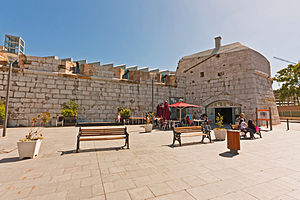King's Bastion
| King's Bastion | |
|---|---|
| Part of Fortifications of Gibraltar | |
| Line Wall, Gibraltar | |

King's Bastion, Gibraltar
|
|

King's Bastion as depicted on the 1865 scale model of Gibraltar.
|
|
|
Location of King's Bastion within Gibraltar.
|
|
| Coordinates | 36°08′23″N 5°21′18″W / 36.139701°N 5.355099°W |
| Type | Coastal battery |
| Site information | |
| Owner | Government of Gibraltar |
| Controlled by | Gibraltar |
| Open to the public |
Yes |
| Condition | Good |
| Website | www |
| Site history | |
| Built | 1773 |
| Built by | British Government |
| In use | 1773 – present |
| Materials | Limestone |
| Battles/wars | Great Siege of Gibraltar |
| Garrison information | |
| Past commanders |
Robert Boyd George Augustus Eliott |
King's Bastion is a coastal bastion on the western front of the fortifications of the British overseas territory of Gibraltar, protruding from the Line Wall Curtain. It is located between Line Wall Road and Queensway and overlooks the Bay of Gibraltar . It played a crucial role in defending The Rock during the Great Siege of Gibraltar. In more recent history the bastion was converted into a generating station which powered Gibraltar's electricity needs. Today it continues to serve the community as Gibraltar's leisure centre.
King's Bastion is located at the junction of Queensway and Reclamation Road on the western side of the British overseas territory of Gibraltar. The bastion is believed to have started as a Moorish city gate but was later developed by the Spanish in 1575 to become the Spanish: Plataforma de San Lorenzo. Construction began in 1773, when Lieutenant-general Sir Robert Boyd (1710–1794), then Governor of Gibraltar, laid the first stone and declared: "This is the first stone of a work which I name the King's Bastion: may it be as gallantly defended, as I know it will be ably executed." The bastion was designed by Lieutenant colonel Sir William Green, Chief Engineer of the Soldier Artificer Company which later became the Corps. of Royal Engineers. At the time it was built, the King's Bastion was the most important of Gibraltar's defences on the west. Its arrowhead shape extended from the curtain wall fortification, known as the Line Wall, along Gibraltar's western coast into the Bay of Gibraltar. It was consistent with traditional notions of a bastion. It included casemates, which fulfilled the need for barracks, and housed 800 men. Less than a decade later, in 1782, King's Bastion served ably as the command post in the defence against the attacks of the French and Spanish during the Great Siege of Gibraltar. It was from the bastion, that the "Grand Attack" of the Spanish floating batteries was orchestrated. The floating batteries had been adapted to withstand heavy shelling and were anchored only 500 metres (550 yd) or so off the Rock. Designed by French engineer Jean Claude le Michaud d'Arcon they were equipped with specially reinforced hulls, irrigation pumps to quench any fires and pitched roofs to protect against plunging fire from shot. These modifications were thought to have made the ships unsinkable. The garrison quickly realised that red hot shots known as "hot potatoes", were extremely effective against the floating batteries and they were all eventually destroyed by fire. It was from King's Bastion that the first "hot potatoes" were fired at the Spanish floating batteries.
...
Wikipedia

